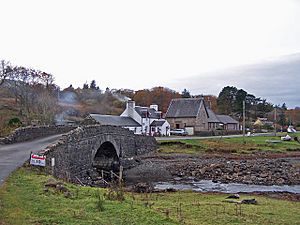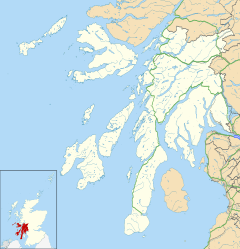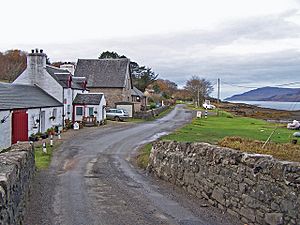Pennyghael facts for kids
Quick facts for kids Pennyghael
|
|
|---|---|
 The white building is 'The Old Smithy', with the Pennyghael Community Hall behind |
|
| OS grid reference | NM517263 |
| Council area | |
| Lieutenancy area | |
| Country | Scotland |
| Sovereign state | United Kingdom |
| Post town | ISLE OF MULL |
| Postcode district | PA67 |
| Dialling code | 01681 |
| Police | Strathclyde |
| Fire | Strathclyde |
| Ambulance | Scottish |
| EU Parliament | Scotland |
| UK Parliament |
|
| Scottish Parliament | |
Pennyghael (which in Scottish Gaelic is Peighinn nan Gàidheal) is a small village in Scotland. It's found on the Isle of Mull, a beautiful island in the area called Argyll and Bute. Pennyghael sits right by the coast, next to a sea loch called Loch Scridain. You'll find it along the A849 road, which leads towards Bunessan. The Leidle River flows past the village and into the loch.
Contents
Exploring Pennyghael's Location
Pennyghael is located on the Ross of Mull, which is a peninsula on the southwestern part of the Isle of Mull.
The Pennyghael Bridge
If you come from the west, you'll cross a small bridge over the Leidle River. This bridge is called Pennyghael Bridge. It's an old bridge, built around 1835-1836, and it's made of stone with a single arch.
The Pennyghael Estate
The land around Pennyghael is known as the Pennyghael Estate. It's a very large area, covering about 10,000 acres (that's about 40 square kilometers!). This estate stretches all the way to the sea cliffs at Carsaig Bay.
Weather Station
Pennyghael even has a special weather station. This station helps scientists observe the weather. It has tools to measure temperature, humidity, and even magnetic activity in the sky, which can tell us about things like the aurora borealis (Northern Lights).
A Look Back in Time: Pennyghael's History
The name Pennyghael might come from an old way of valuing land. Long ago, land was sometimes measured in "pennies" or parts of a penny. So, "Pennyghael" could mean "The Pennyland of the Gael," referring to the Gaelic people who lived there.
Ancient Times
People have lived in the Pennyghael area for a very long time. Scientists have found ancient stone structures called cairns near a place called Burg. These cairns show that people were living here as far back as 4000 BC, during the Neolithic period (the New Stone Age).
Later, around 600 BC, during the Iron Age, farmers worked the land around Loch Scridain. In the first century AD, people from Norway and Denmark visited or settled in the area. You can still see their influence in some of the place names today.
Clan MacGillivray
The Clan MacGillivray was a very important family in Pennyghael for many centuries. It's thought that they arrived around 327 AD. By the 1390s, another powerful family, the MacLean of Duarts, had control of the area.
The first official record of a "Laird" (a Scottish landowner) of Pennyghael was Archibald McGillivray in 1542. The MacGillivrays continued to be important landowners. For example, Donald MacGillivray was the laird in 1618, and Alexander MacGillivray was the laird in 1751.
Community Efforts Today
In 2000, the Pennyghael Development Association (PDA) was created. This group is a charity that works to help the community. In 2005, they worked to buy the old school building in Pennyghael and planned to turn it into a community center. They raised money from local people to make this happen.
Cool Places to See in Pennyghael
Pennyghael has several interesting buildings and landmarks.
Community Hall and School
The Pennyghael Community Hall is a building with a tall roof where local events and gatherings take place. There's also Pennycross School, which was built in 1872 and is made of square pink granite.
Crois an Ollaimh
About 80 meters north of Pennyghael House, you can find a stone cross monument. It's called the Crois an Ollaimh, and it's a rough-cut, Latin-style cross.
Hotels and Historic Buildings
- Smithy House: This white building, also known as The Old Smithy, is now used as a guest house.
- Kinloch Hotel: This old hotel, built in the early 1800s, is about 3 kilometers northeast of Pennyghael.
- Pennyghael Hotel: This hotel is a charming country hotel located in a 17th-century farmhouse. It has six rooms, and many of them offer views of Loch Scridain or Ben More. You might even spot a white-tailed eagle nest from some rooms! The hotel's restaurant serves delicious local food like crab, mussels, pork, and Tobermory cheese.
- Pennyghael Lodge: This building was built in the 1700s and was expanded over the years, but it is now abandoned.
- Rossal Farm: This two-story farmhouse dates back to the early 1800s and was restored in the 1980s.
The nearby Carsaig Estate and the area around it were used as a filming location for the movie The Silent Storm.
Animals and Nature in Pennyghael
The Pennyghael Estate is a great place to see wildlife.
Mammals
You might spot two families of otters living on the northern shore. There's also a seal colony on a reef nearby called Killunaig. On the moors, you can see red deer. Other animals that live here include wild goats.
Birds
Pennyghael is a fantastic spot for birdwatching! You can see many different kinds of birds, including:
- Small Birds: Meadow pipits, rock pipits, wheatears, redstarts, chaffinches, greenfinches, and blackbirds.
- Seabirds: Large gulls like great black-backed gulls, lesser black-backed gulls, and common gulls. You might also see gannets and shearwaters.
- Birds of Prey: Look out for peregrine falcons, hen harriers, ravens, buzzards, and majestic golden eagles, especially on the Carsaig hills.
- Water Birds: In the loch, you can find eider ducks, black guillemots, guillemots, black-throated divers, red-throated divers, and great-northern divers. Near the shores, you'll see oystercatchers, curlews, redshanks, and ringed plovers.
- Other Birds: swallows often nest near barns, and you might see common sandpipers, lapwings, and whitethroats around the loch. In the forested areas, eared owls have been recorded.



